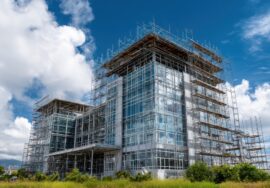Climate-Resilient Infrastructure: Building for the Future
Climate-Resilient Infrastructure: Building for the Future
As climate change continues to intensify, the need for climate-resilient infrastructure has become more critical than ever. This type of infrastructure is designed to withstand and adapt to the impacts of climate change, ensuring that buildings, roads, bridges, and other structures remain functional and sustainable in the face of extreme weather events. The future of urban development lies in creating infrastructure that is not only durable but also adaptable to the changing climate.
What is Climate-Resilient Infrastructure?
Climate-resilient infrastructure refers to structures that are built or modified to endure the challenges posed by climate change. These challenges include extreme weather patterns like floods, heatwaves, droughts, and storms. Climate-resilient infrastructure involves using innovative materials, designs, and technologies to make infrastructure more robust and adaptable to these changes.
Key Features of Climate-Resilient Infrastructure
- Durable Materials: The use of advanced materials that can withstand extreme weather conditions, such as heat-resistant concrete, flood-resistant barriers, and windproof roofing systems.
- Flood Protection: Incorporating features like floodwalls, elevated structures, and permeable pavements to manage water flow and reduce the risk of flooding.
- Energy Efficiency: Designing buildings and infrastructure to be energy-efficient, reducing the carbon footprint and the demand on energy resources during periods of extreme weather.
- Green Infrastructure: Integrating nature-based solutions such as green roofs, urban trees, and stormwater management systems to enhance the natural environment’s role in mitigating climate risks.
Benefits of Climate-Resilient Infrastructure
Adopting climate-resilient infrastructure offers numerous benefits for communities, businesses, and governments. Some of the most significant advantages include:
1. Enhanced Safety and Protection
Climate-resilient infrastructure is designed to protect communities from the impacts of extreme weather events such as floods, storms, and heatwaves. By strengthening the structural integrity of buildings and infrastructure, these projects ensure the safety of residents and prevent damage to property.
2. Reduced Long-Term Costs
While the initial investment in climate-resilient infrastructure may be higher, the long-term savings are significant. By reducing the frequency and severity of climate-related damage, these projects lower repair and maintenance costs over time. Additionally, they help avoid the economic disruptions caused by climate events, such as business closures and reduced productivity.
3. Promotes Sustainable Urban Development
Climate-resilient infrastructure encourages sustainable urban growth by prioritizing energy efficiency, water conservation, and green spaces. This results in healthier environments, reduced environmental footprints, and a higher quality of life for residents.
4. Economic Growth and Job Creation
Investing in climate-resilient infrastructure projects can stimulate economic growth by creating jobs in construction, design, and maintenance. These projects also attract investments by creating a stable environment where businesses can thrive despite climate uncertainties.

Key Elements of Climate-Resilient Infrastructure
To ensure infrastructure can withstand the impacts of climate change, several key elements must be incorporated during the planning and design phases:
1. Risk Assessment and Planning
The first step in creating climate-resilient infrastructure is conducting a thorough risk assessment. This involves analyzing the potential climate-related hazards in a specific area, such as flooding, extreme temperatures, or rising sea levels. Once the risks are identified, infrastructure projects can be tailored to minimize these risks.
2. Adaptation Strategies
Adaptation strategies are crucial in ensuring infrastructure is resilient to climate impacts. These strategies can include elevated buildings to prevent flooding, heat-resistant materials to combat extreme temperatures, and stormwater management systems to reduce the impact of heavy rainfall.
3. Sustainable Design Practices
Incorporating sustainable design practices, such as energy-efficient systems, renewable energy sources, and water-saving technologies, helps reduce the environmental footprint of infrastructure projects. These practices not only contribute to climate resilience but also promote long-term sustainability.
4. Use of Green Infrastructure
Green infrastructure includes nature-based solutions like urban forests, green roofs, and permeable pavements that help manage stormwater, reduce urban heat islands, and enhance biodiversity. By integrating green infrastructure into urban planning, cities can better adapt to climate change while improving residents’ quality of life.
Climate-Resilient Infrastructure in India
India is already experiencing the effects of climate change, including rising temperatures, flooding, and droughts. To address these challenges, the government and private sector are investing in climate-resilient infrastructure. Initiatives like the National Action Plan on Climate Change (NAPCC) and the Smart Cities Mission emphasize the importance of building infrastructure that can adapt to climate risks.
For instance, Mumbai, a city prone to flooding and heatwaves, has implemented green infrastructure projects such as the creation of urban forests and rainwater harvesting systems. These projects aim to mitigate the impacts of flooding and reduce the urban heat island effect, making the city more resilient to climate change.
The Indian Green Building Council (IGBC) also promotes the adoption of green building standards that encourage climate-resilient design and construction practices. You can learn more about India’s efforts toward building climate-resilient infrastructure through this article on India’s climate adaptation strategies or read about the role of green buildings in India here.
Conclusion
Building climate-resilient infrastructure is essential to securing a sustainable and resilient future. By designing and constructing infrastructure that can withstand the impacts of climate change, we are not only protecting communities but also promoting economic growth, sustainability, and long-term environmental health. As more cities and countries embrace these practices, climate-resilient infrastructure will be pivotal in addressing the challenges of a changing climate.
For expert guidance on incorporating climate-resilient infrastructure into your projects, feel free to contact us.
Construction Industry in India
- One of India’s largest construction and engineering companies, Campus Construction Cost Optimization provides services including project management, cost control, and engineering consultancy. For detailed information on their offerings, visit. Construction Industry in India
Read more related articles to enhance your knowledge and make informed decisions
10 Essential Steps in the Building Construction Process
How to Choose the Right Materials for Your Construction Project









